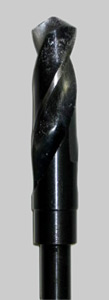Home | Glossary | Resources | Help | Contact Us | Course Map
Archival Notice
This is an archive page that is no longer being updated. It may contain outdated information and links may no longer function as originally intended.
Deep Hole Drilling
The initial steel bar has a straight exterior profile. This allows for better alignment in boring and rifling machines and the stiffness needed to resist deformation due to heating. The first step is the critical deep-drill operation to produce a straight hole the entire length of the barrel. The diameter of the hole depends on the downstream rifling equipment. For cut rifling, the hole is smaller than the bullet that will be fired; for forged rifling , the hole must be larger.
The drilling operation requires excellent support of all tooling and the barrel stock to produce a straight hole. Drilling speed is dictated by the diameter of the hole. A large diameter hole can be drilled faster than a small diameter hole because the stiffness of the larger drill shaft resists warping.
| Note: |
| The speed of drilling was a major factor in the introduction of mass-produced .17 caliber firearms. Prior to the year 2000, drilling the .17 caliber bore required painfully slow drilling and was generally performed only by small, custom barrel makers. The major manufacturers developed new technology to make tiny straight holes at a production rate acceptable to their cost requirements. |
Drilling produces significant marks useful to the firearms examiner. Chips produced by drilling often nick the surface before lubricants flush them from the hole, adding to the randomness of the marks. Drilling marks run perpendicular to the axis of the bore, leaving little chance of carry-over of marks from one barrel to the next.
Typically, gun drills are sized to produce a finished hole that is a few ten-thousandths of an inch under the desired diameter. The next operation removes this small discrepancy.
Reaming
In spite of the great care given to making straight holes, barrel makers normally further process the bore following drilling to smooth the surface, correct minor variations in straightness, and establish the final bore diameter. The bore diameter is the minor diameter of the finished rifled barrel. A typical finished .30 caliber barrel made to Sporting Arms and Ammunition Manufacturers Institute, Inc. ( SAAMI) standards has a major diameter (groove-to groove) of 0.308 inches and a minor diameter (land-to-land) of 0.300 inches. Reaming is the operation of choice for finishing the bore to 0.300 inches before rifling.
A reamer for refining a drilled bore is a long cutting tool with its working edges on the sides. The diameter of the reamer is typically the same as the final bore diameter. To assure proper alignment and straightness, the reamer is much longer, compared to its diameter. A typical reamer for this operation will have a length ten to twenty times its diameter for precision alignment. This assists in aligning the reamer as it passes through the barrel.
Reaming reduces roughness inherent in drilled holes. Because the reamer is required to remove very little metal, the working edges are finely honed. The surface of the barrel hole is smooth, yet reaming can leave markings that may ultimately be passed to a fired bullet.
Lapping
Any cutting operation, including reaming, leaves microscopic projections or burrs on the processed surface. After reaming, an in-process barrel can be taken to the rifling stage and still produce a decent barrel. However, high-grade barrels or those destined to fire soft lead bullets may be polished (called lapping) prior to rifling. Typical bore lapping uses an abrasive paste on a soft lead cylinder. It is passed through the bore several times, reducing any burrs. The size of imperfections is minimized by applying a fine grinding paste. Finer grade grit paste produces smoother surfaces. If required, pastes (properly graded for grit size) can produce a mirror finish in metals.
Straightening
After reaming and/or lapping, barrels may be straightened. An operator aims the barrel at an optical pattern on a nearby wall. The pattern design is such that its reflection on the interior surface of the barrel reveals the straightness of the bore, relative to the long axis. If the reflection indicates that the bored hole is not concentric to the axis, the operator places the barrel in a large hand press and applies pressure to points on the barrel that will improve straightness.
Barrel straightening is a manual operation that requires a very skilled operator, adding to the cost of the barrel-making operation. It behooves the designers and operators of barrel-making equipment to create and maintain machines that produce straight barrels every time.
See the YouTube Terms of Service and Google Privacy Policy
Additional Online Courses
- What Every First Responding Officer Should Know About DNA Evidence
- Collecting DNA Evidence at Property Crime Scenes
- DNA – A Prosecutor’s Practice Notebook
- Crime Scene and DNA Basics
- Laboratory Safety Programs
- DNA Amplification
- Population Genetics and Statistics
- Non-STR DNA Markers: SNPs, Y-STRs, LCN and mtDNA
- Firearms Examiner Training
- Forensic DNA Education for Law Enforcement Decisionmakers
- What Every Investigator and Evidence Technician Should Know About DNA Evidence
- Principles of Forensic DNA for Officers of the Court
- Law 101: Legal Guide for the Forensic Expert
- Laboratory Orientation and Testing of Body Fluids and Tissues
- DNA Extraction and Quantitation
- STR Data Analysis and Interpretation
- Communication Skills, Report Writing, and Courtroom Testimony
- Español for Law Enforcement
- Amplified DNA Product Separation for Forensic Analysts



